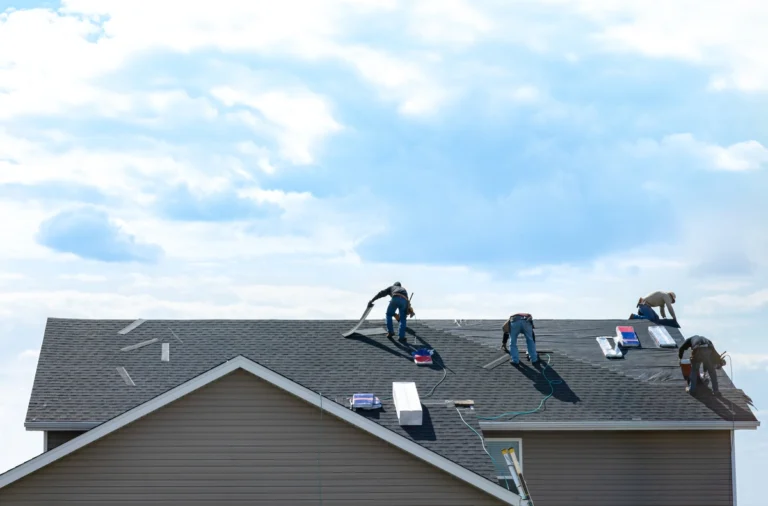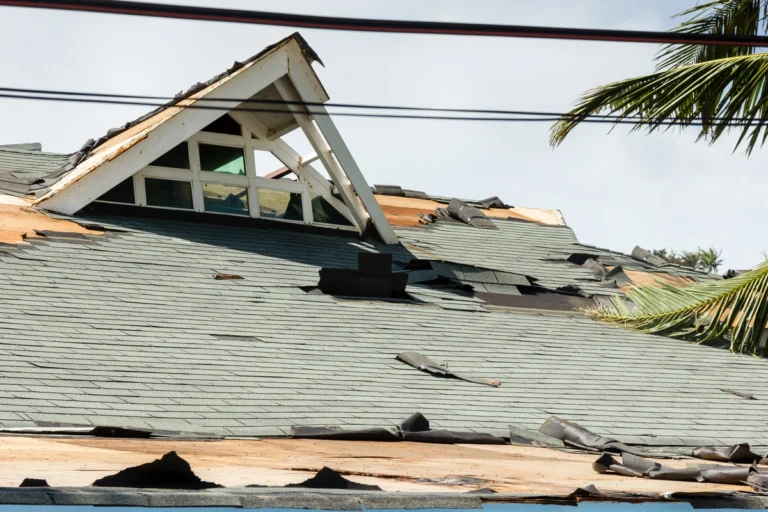As a homeowner, there comes a time when you must confront the reality of a roof replacement. It’s a significant undertaking that can protect your investment and ensure the safety and comfort of your family. However, it also raises several important questions, one of which is, “Should I stay home during a roof replacement?“
In this comprehensive guide, we will explore the signs that indicate it’s time to replace your roof, including:
- Whether you should stay home during roofing work
- How to find a reputable roofing contractor
- The step-by-step process of roof replacement
Ready to make some plans? Keep reading!
Should You Stay Home During a Roof Replacement?

The decision to stay home during a roof replacement ultimately depends on several factors, including your personal preferences, the scope of the project, and the contractor’s policies. Here are some considerations to help you make an informed choice:
- Safety Concerns: Safety should always be a top priority. If you have concerns about your family’s safety during the project, especially if you have young children or elderly residents, it may be best to temporarily relocate while the work is underway. Falling debris and equipment can pose hazards.
- Noise and Disruption: Roof replacement can be a noisy and disruptive process. If you’re sensitive to loud noises or find it challenging to concentrate with construction activity overhead, you might prefer to stay elsewhere during the project.
- Pets: Consider the needs of your pets. The noise and disturbance caused by a roof replacement can be distressing to animals. If you have pets, it may be more comfortable for them to stay elsewhere during the construction.
- Contractor’s Policies: Discuss the contractor’s policies regarding homeowner presence during the project. Some contractors may prefer homeowners to be away for safety and liability reasons, while others may be more flexible.
- Communication: Maintaining open communication with your contractor is essential. If you choose to stay home, make sure you understand the safety guidelines and work schedules. Be prepared for some inconvenience and noise.
- Duration of the Project: Consider the estimated duration of the roof replacement project. If it’s a relatively quick project, you may opt to stay home, whereas longer projects might necessitate temporary relocation.
- Personal Comfort: Ultimately, your comfort level is paramount. If you feel more at ease staying home during the roof replacement, and it aligns with the contractor’s guidelines, then it’s a viable option.
- Alternative Accommodations: If you decide to stay elsewhere during the roof replacement, make arrangements for alternative accommodations with friends or family, or consider staying in a hotel or rental property.
- Follow Local Regulations: Be sure to follow any local regulations or guidelines regarding homeowner presence during construction projects. Some areas may have specific rules in place.
8 Signs That It’s Time to Replace Your Roof
Before you ultimately decide whether or not you should stay home during a roof replacement, it’s crucial to understand the signs that indicate your roof needs replacement. Ignoring these signs can lead to more significant problems down the road, including water damage, mold growth, and structural issues. Here are some key indicators that it might be time to replace your roof:
1. Age of the Roof 👵🏼

Most roofing materials have a limited lifespan. Asphalt shingles typically last between 20 to 30 years, while other materials like metal or tile can last significantly longer. If your roof is nearing the end of its expected lifespan, it’s time to start considering a replacement.
2. Missing or Damaged Shingles 🔎
Visible damage to your roof, such as missing, cracked, or curled shingles, is a clear sign that your roof needs attention. Damaged shingles can allow water to penetrate and lead to leaks.
3. Roof Leaks 💧
If you notice water stains on your ceiling or walls, it’s a clear indication that your roof has a leak. Roof leaks can be caused by damaged shingles, deteriorated flashing, or other structural issues.
4. Sagging or Warped Roof 🏚️
A sagging or uneven roofline can be a sign of serious structural problems, often caused by underlying issues that require immediate attention.
5. Increased Energy Bills 📈
An aging or damaged roof can result in poor insulation, leading to higher energy bills. If your heating and cooling costs have been steadily rising, it might be due to your roof’s inefficiency.
6. Granule Loss 🧹
Check your gutters for excessive granule loss from your shingles. Granules help protect shingles from UV rays, and their loss can indicate shingle deterioration.
7. Mold or Algae Growth 🍄
The presence of mold or algae on your roof is not only unsightly but also a sign of moisture retention, which can accelerate shingle deterioration.
8. Daylight Through the Roof ☀️
If you can see daylight through your attic’s roof boards, it’s a definite sign of roof problems that require immediate attention.
If you’ve noticed any of these signs, it’s crucial to have your roof inspected by a professional roofing contractor to assess the extent of the damage and determine if replacement is necessary.
How to Find a Reputable Roofing Contractor

Choosing the right roofing contractor is a critical step in ensuring a successful roof replacement project. Here are some essential tips for finding a reputable roofing contractor:
- Research and Recommendations: Start by asking for recommendations from friends, family, or neighbors who have recently had their roofs replaced. Word of mouth is often one of the most reliable ways to find a trustworthy contractor.
- Check Credentials: Verify that the roofing contractor is licensed, insured, and bonded. A reputable contractor should have the necessary credentials to perform roofing work legally and safely.
- Read Reviews: Look for online reviews and testimonials from previous customers. Websites like Angie’s List, Yelp, and the Better Business Bureau can provide valuable insights into a contractor’s reputation.
- Request References: Ask the contractor for a list of references from past clients. Contact these references to inquire about their experiences and satisfaction with the contractor’s work.
- Get Multiple Quotes: Obtain quotes from several roofing contractors to compare prices and services. Be wary of contractors who offer significantly lower prices, as they may cut corners or use subpar materials.
- Warranty: Inquire about the warranties offered on both the roofing materials and the contractor’s workmanship. A reputable contractor should stand behind their work with a warranty.
- Communication: Choose a contractor who communicates effectively and is responsive to your questions and concerns. Good communication is essential throughout the roofing project.
- Local Knowledge: Select a contractor with local knowledge and experience. They should be familiar with the specific weather challenges and building codes in your area.
The Roof Replacement Process Step-by-Step
Once you’ve selected a reputable roofing contractor and decided to move forward with the replacement, it’s essential to understand what the roof replacement process entails. While every project may vary slightly, here is a general overview of the steps involved:
1. Inspection and Assessment:
The process begins with a thorough inspection of your existing roof by the contractor. They will assess the condition of the roofing materials, identify any structural issues, and determine the scope of work required.
2. Material Selection:
You’ll work with the contractor to choose the roofing materials that best suit your needs and budget. Options may include asphalt shingles, metal roofing, tile, or other materials.
3. Permits and Documentation:
Your contractor will secure any necessary permits and documentation required by local building codes and regulations.
4. Preparation:
Before installation begins, the contractor will prepare the site. This may involve removing the old roofing materials, inspecting and repairing the roof deck, and installing protective underlayment.
5. Installation:
The new roofing materials are installed according to manufacturer specifications and local building codes. This includes the installation of flashing, vents, and other necessary components.
6. Clean-Up:
After the installation is complete, the contractor will thoroughly clean the work area, removing debris and nails to ensure safety and prevent damage to your property.
7. Inspection and Quality Control:
A final inspection is conducted to ensure the roof replacement meets quality standards and complies with all regulations.
8. Warranty:
The roofing contractor provides you with documentation of the warranty for both materials and workmanship.
Let Us Do The Dirty Work
Whether or not homeowners should stay home during a roof replacement is a personal decision that depends on various factors. Safety, comfort, and the contractor’s policies all play a role in making the right choice.
Are you looking for a trustworthy roofing contractor that can make the replacement process stress-free? Bay Valley Roofing is here to help! Whatever roofing material you want, our knowledgeable team is ready to tackle it head-on. Contact us today to set up your free roof inspection!





